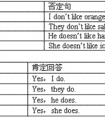用所给动词的适当形式填空 1.Tomorrow is my birthday. They are talking about ___________(have) a birthday party for me.2. It’s 8:30 p.m. now. My parents __-七年级英语
妻子骑牛拿起刀,wife,calf,knife ↑
追得贼狼满街跑,thief,wolf →→→变f或fe为v,再加es
碰倒架子丧己命,shelf,self,life ↓
手帕树叶半空飘。handkerchief,leaf,half ↓
1.不规则形式:
child→children(儿童)
man→men(男人)
woman→women (女人)
an Englishman→two Englishmen(英国人)
foot→feet(脚)
tooth→teeth(牙)
mouse→mice(老鼠)
ox →oxen(公牛)
goose→geese(鹅)
2.单复同形:
deer,sheep,fish,Chinese,Japanese, species,means,Swiss
除人民币,美元、英镑、法郎等都有复数形式。
如:a dollar,two dollars; a meter,twometers
3.集体名词,以单数形式出现,但实为复数:
people police cattle是复数
(OK :a person,a policeman,ahead of cattle,the English,the British,the French,the Chinese,the Japanese,the Swiss )
(Error:a people,a police,a cattle )
表示国民总称时,作复数用。
(The Chinese are industries and brave. 中国人民是勤劳勇敢的。)
4.以s结尾,仍为单数的名词
maths,politics,physics等学科名词,为不可数名词,是单数。
news是不可数名词。
5.表示由两部分构成的东西,
glasses(眼镜) trousers (长裤) clothes(衣服)
若表达具体数目,要借助数量词pair(对,双)a pair of glasses two pairs of trousers suit(套)
6.另外还有一些名词,其复数形式有时可表示特别意思
goods (货物) waters (水域) fishes (各种鱼)
1) 单数名词加s: students, apples, bags, trees, books, brothers.
2) 以s、x、sh、ch结尾的名词加es: glasses, boxes, brushes, matches.
3) 以辅音字母加y结尾的名词,变y为i加es: cities, babies, enemies.
4) 以f或fe结尾的名词,多数变f为v加es: wives, knives.但有些词只加s: roofs,proofs, chiefs.
5) 以o结尾的名词,有些加es: Negroes, heroes, tomatoes, potatoes. 其它加s: radio s, zoos, pianos, photos.
6) 不规则名词:foot→feet, goose→geese, tooth→teeth, child→children, man→men, woman→women, mouse→mice.
7) 单复数同形的名词:sheep,fish,dee.
注意:fish表示种类时,也用fishes这样的形式。
考点名称:序数词
- 序数词:
是数词的一种,主要在英语语法中讲到,在汉语中表示为“第几”。如:first, second, third, fourth 序数词的读法与写法:
序数词写法:
1 first ;2 second ; 3 third ;4 fourth ; 5 fifth ;
6 sixth ;7 seventh; 8 eighth;9 ninth ;10 tenth ;
11 eleventh ;12 twelfth ;13; thirteenth ;14 fourteenth;15 fifteenth
16 sixteenth ;17 seventeenth ;18 eighteenth;19 nineteenth;
20 twentieth ;30 thirtieth ;40 fortieth ;50 fiftieth ;60 sixtieth ;70 seventieth;80 eightieth ; 90 ninetieth多位序词:
由基数词的形式变结尾部分为序数词形式来表示。
one hundred and twenty-first 第一百二十一
one thousand three hundred and twentieth 第一千三百二十
two hundred and fifty-second 第二百五十二缩写:
有时,序数词可以用缩写形式来表示。主要缩写形式有:
first——1st ;second——2nd ;third——3rd; fourth——4th ;sixth——6th ;twentieth——20th;twenty-third——23rd
其中lst,2nd,3rd为特殊形式,其它的都是阿拉伯数字后加上th。序数词前不加the的情况:
在英语中,使用序数词时前面要加定冠词 the,但是,在下面的情况下则不加 the:
1.当序数词前有形容词性物主代词或名词所有格修饰时,序数词前不用 the。
Mother was my first teacher in my life.妈妈是我生命中的第一个老师。
Tom is Lily's third boyfriend. 汤姆是莉莉的第三个男朋友。
2.当表达分数时,序数词前不用 the。
One fifth of the students here are from the country. 这儿1/5的学生来自农村。
Three fourths of the students here are from the country. 这儿的3/4的学生来自农村。
3.当表达“又一,再一”时,序数词前不用 the,但可加不定冠词。
Please give me a second chance. 请再给我一次机会。
The poor woman had a third baby. 那个可怜的妇女又生了第三个宝宝。
4.当表达“年月日”时,尤其在朗读时,序数词前要加 the。
He was born on June 6th, 1974. 他出生在1974年6月6日。
5.当序数词在句中作状语时,序数词前不用 the。
Who got there second? 谁第二个到那儿的?
I finished the work first. 我最先完成那项工作。
6. 当表达考试(比赛等)中获得的名次时,序数词前不用 the。
She stands first in her class. 她在班上成绩排名第一。基数词变序数词的口诀:
基变序,有规律,词尾加上-th。
一,二,三,特殊记,词尾字母t,d,d。
八去t,九除e,ve要用f替,ty将y变成i,th前面有个e。
若是碰到几十几,前用基来后用序。
整十基数变序数,先把ty变成tie,要是遇上两位数,十位基数,个位序,th最后加上去。
或者一,二,三变字体;th从4上起;8加h,9减e;用f 代ve;ty变为tie。序数词的语法功能及用法:
序数词在句中可作主语、宾语、定语和表语。
The second is what I really need. 第二个是我真正需要的。(作主语)
He choose the second. 他挑选了第二个。(作宾语)
We are to carry out the first plan. 我们将执行第一个计划。(作定语)
She is the second in our class.在我们班她是第二名。(作表语)
注:序数词在使用时,通常前面要加定冠词 the;但是如果序数词前出现不定冠词a或an时,则表示“再—”,“又—”。
We'll go over it a second time. 我们得再念第二遍。
We've tried it three times.Must we try it a fourth time? 我们已经试过三遍了,还必须试一次(第四次)吗?
表示顺序的序数词
只需将基数词放在它所修饰的名词之后即可,不需要添加定冠词。
the first lesson——Lesson One the fifth page——Page 5(five)
the twenty-first room——Room 21(twenty-one)
考点名称:情态动词
- 情态动词:
是一种本身有一定的词义,表示说话人的情绪、态度或与语气的动词,但不能单独作谓语,只能和其他动词原形构成谓语。
无人称和数的变化,情态动词后面跟的动词需用原形,否定式构成是在情态动词后面加 “not”。
个别情态动词有现在式和过去式两种形式,过去式用来表达更加客气,委婉的语气, 时态性不强,可用于过去,现在或将来。情态动词属非及物动词,故没有被动语态。
情态动词有四类:
①只做情态动词:must, can(could),may(might)……
②可做情态动词又可做实义动词:need, dare
③具有情态动词特征:have(had, has) to, used to
④情态动词表猜测
注:mustn't代表强烈禁止 must表示主观,have to表示客观。
常用的有:can may could must have use . 情态动词特点:
情态动词无人称和数的变化,情态动词后面跟的动词须用原形,否定式构成是在情态动词后面加 "not"。
个别情态动词有现在式和过去式两种形式,过去式用来表达更加客气,委婉的语气,时态性不强,可用于过去,现在或将来。情态动词属非及物动词,故没有被动语态。
He could be here soon.他很快就来。
We can't carry the heavy box.我们搬不动那箱子。
I'm sorry I can't help you.对不起,我帮不上你。
基本助动词与情态助动词最主要的区别之一是:
基本助动词本身没有词义,而情态助动词则有自己的词义,能表示说话人对有关动作或状态的看法,或表示主观设想:
What have you been doing since? (构成完成进行体,本身无词义)
I am afraid I must be going. (一定要)
You may have read some account of the matter. (或许已经)
除此之外,情态助动词还有如下词法和句法特征:
1) 除ought和used以外,其他情态动词后面只能接不带to的不定式。如果我们把ought to和used to看做是固定词组的话,那么,所有情态动词无一例外地只能接不带to的不定式:
We used to grow beautiful roses.我们过去常常种这种漂亮的玫瑰花
I asked if he would come and repair my television set.我问他是否来修我的电视机
- 最新内容
- 相关内容
- 网友推荐
- 图文推荐
| [家长教育] 孩子为什么会和父母感情疏离? (2019-07-14) |
| [教师分享] 给远方姐姐的一封信 (2018-11-07) |
| [教师分享] 伸缩门 (2018-11-07) |
| [教师分享] 回家乡 (2018-11-07) |
| [教师分享] 是风味也是人间 (2018-11-07) |
| [教师分享] 一句格言的启示 (2018-11-07) |
| [教师分享] 无规矩不成方圆 (2018-11-07) |
| [教师分享] 第十届全国教育名家论坛有感(二) (2018-11-07) |
| [教师分享] 贪玩的小狗 (2018-11-07) |
| [教师分享] 未命名文章 (2018-11-07) |

![Which of the following can you probably see in the meeting room? [ ]A. B. C.D. -七年级英语](http://www.00-edu.com/d/file/ks/4/2/dongmingci/2020-01-08/small97361980a56115e1c9237567439904fe1578422951.jpg)

![—Can the boy finish_____ the book in about a week? —I think he can. [ ]A. read B. reading C. to read D. reads -八年级英语](http://www.00-edu.com/d/file/ks/4/2/dongmingci/2020-01-08/smallfa4d713075e249356362fe7392193a301578421751.png)


